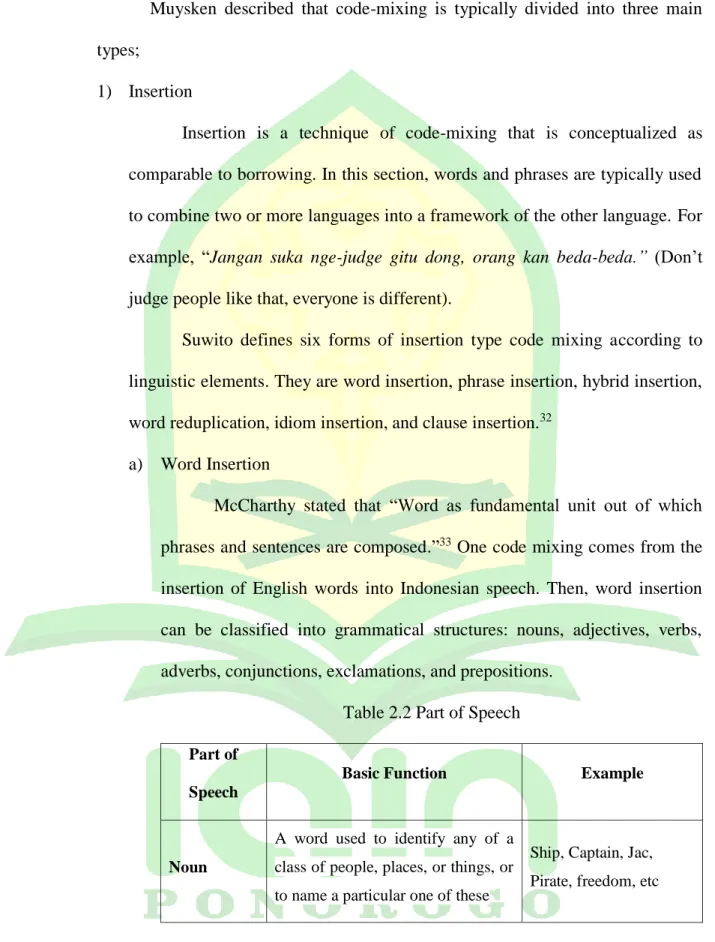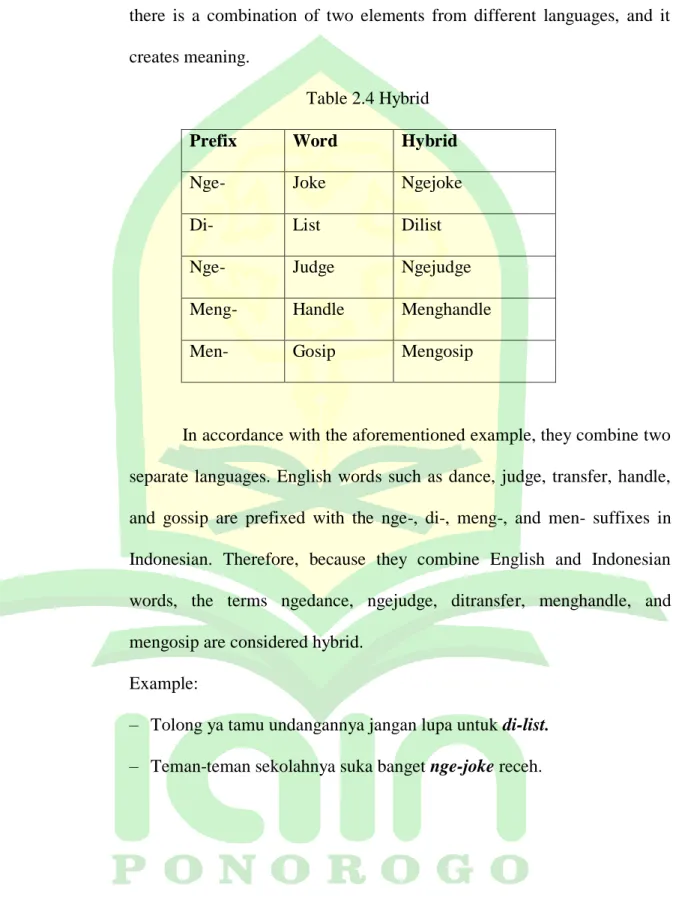Title: Code-switching and code-mixing in English conversation among students in an Islamic boarding school. Based on the background explanation, the author wants to conduct a research titled "Code-Switching And Code-Mixing Of English Conversation Among Students In Islamic Boarding School".
Research Problems
Regarding the code-switching and code-mixing involved in oral communication, the researcher wants to examine the code-switching and code-mixing involved in the daily conversation of the students and the committee in the Islamic Dormitory.
Objectives of The Study
Significance of The Study
Organization of The Study
Theoretical Background 1. Bilingualism
Code
According to Weinreich, cited by Offiong and Okon, code switching occurs mainly in bilingual communities. Code-mixing is a term used to describe a broader category of language contact, including instances of code-switching and other interactions that place more emphasis on lexical components. A similarity between code-switching and code-mixing is the fact that two or more languages are used or that there are two dialects of one language.
According to the different views discussed here, the differences between code-switching and code-mixing are summarized in the table below. At least this code switching event can be classified into several classifications according to several experts. External code switching occurs between one's own language (one of the languages in the verbal repertoire of the speaking community) and a foreign language, such as switching from Indonesian to English.
Sihite, “Code Mixing and Code Switching Used in English Teaching at Jambi University,” Thesis Proposal (2016). So the insertion of the clause here is not some kind of code-mixing, but code-switching. 37 Maya Sari, et al., “Code-Switching and Code-Mixing Used by a Guest Star in Hotman Paris,” JELL, Vol. 5, No.
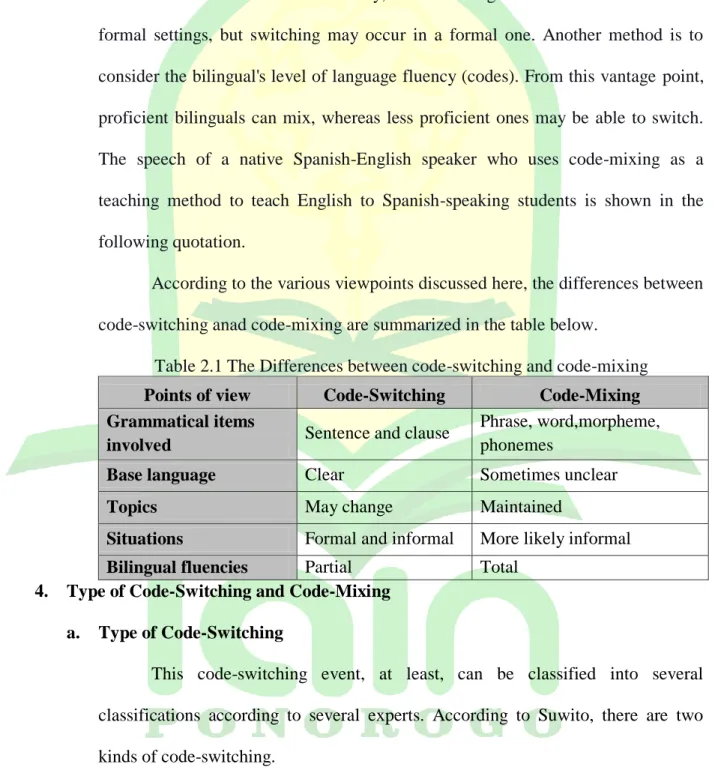
Factor of Code-Switching and Code-Mixing
Hoffman claims that sentence interjections or linking can sometimes be characterized by language switching and mixing among bilingual or multilingual individuals. Sometimes a person speaks in a bilingual or multilingual language, and the listener does not understand well, so the speaker has to explain his speech. When bilinguals or multilinguals talk to other bilinguals or multilinguals, there will be a lot of code-switching and code-mixing.
Because English is not their native language, Indonesian people can soften a request or command by code-switching or mixing it with Indonesian in their speech. Code-switching and code-mixing can strengthen an order because they allow the speaker to speak in a language that not everyone can understand. The most common reason for bilingual/multilingual people to switch or mix their languages is the lack of lexical equivalents in the language.
For example, in Indonesia, technical topics are closely related to English, and the problems themselves can trigger a transition or mixing to/with English.
Conversation
The truth lies in the competence of the conversation, which has different analytical models in the structure of the conversation. Richardt argues that conversation is a face-to-face oral interaction between two or more participants.43 However, a conversation is much more than an exchange of information. When people participate in it, they enter into the conversation process, the assumptions and expectations about the conversation, how the conversation takes place, and the type of contribution they are expected to make.
The conversation is an example of a speech event whose norms can be separated from other speech events, such as lectures, arguments, discussions, religious rituals, court processes, interviews, debates, and meetings. If the participants in the conversation want to have common goals, they must implicitly agree with the method of conversation used. This requirement is a system of a conversation turn, so that the conversation in its entirety moves from one person to another.
This partner helps open the conversation, negotiate the relationship between facts, exchange topics, and close the conversation.
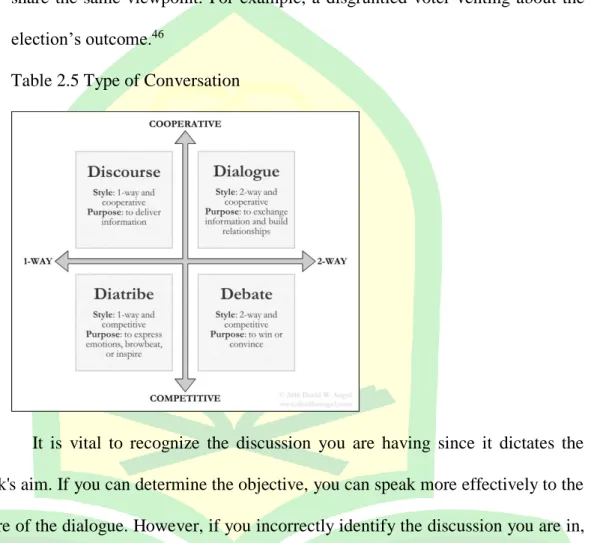
Previous Related Studies
Then, another study titled "Code-switching and code-mixing in Korean TV after-school music show" was published by Fithria Luthfiyani. This study aims to identify types and define elements of code-switching and code-mixing in the After School Club music program. By looking at and noticing some utterances that involve code mixing and switching, the writer uses the descriptive analysis method to analyze them.
The results of this study indicate that 9 out of 16 utterances are code-switching situations and 7 out of 16 are code-mixing cases. The most common elements that influence the phenomenon of code-mixing and -switching are participant and topic, in which the speaker mixes or switches languages due to changing a particular participant or topic in the conversation.50. 50 Fithria Luthfiyani, “Code-switching and code-mixing on Korean TV music show After School Club” (Thesis, UIN Syarif Hidayatullah, Jakarta, 2014).
Research Design
Researcher’s Role
Research Setting
Data and Source of Data
Data Collection Technique 1. Observation
It is also a place where communication takes place in English and several other languages. As an interviewer, the researcher asked questions, asked for clarifications, and took notes in order to get more in-depth information about the code-switching and mixing students use in everyday conversation. The interview method of data collection involves the presentation of verbal-verbal stimuli and responses in the form of verbal-verbal responses, and this method can be used with personal interviews.54 Here, the researcher interviewed a committee and several students to ask questions about the code-switching phenomenon and of code-mixing in As-Sa'idiyyah 2 Bahrul Ulum Islamic boarding school.
The researcher also interviewed the committee and the students to determine what factors caused the committee and students at the Pondok Pesantren to do code-switching and code-mixing. The researcher writes in detail and describes exactly what the researcher sees, hears, experiences and learns during observations and interviews. Field notes are written accounts of what a qualitative researcher heard, saw, felt and thought while collecting and reflecting on data.55 Field notes should be recorded after each observation and after more casual contact with informants, such as casual meetings and telephone conversations. 56 The researcher wrote the results of student and committee observations and in-depth interviews.
The researcher also recorded discussions of code switching and mixing while speaking regularly in many languages.
Data Analysis Technique
The transcripts were then analyzed to identify those utterances believed to be code-switching and code-mixing phenomena and those that were not. The most popular method of data display in qualitative research, essays, was used by the researcher in this study. The reduced data in this study is then described as research data that includes code-switching and code-mixing in tabular form.
The data were used for analysis and had code-switching or code-mixing - different statements of students and committees of code-mixing and code-switching of students of Islamic boarding school As-Sa'idiyyah 2 Bahrul Ulum. First, the researcher uses the following method to account for the various forms of code-switching and code-mixing that occur during speech. Second, the researcher uses the formula shown below to determine the percentages of each type of code switching and code mixing.
After examining the data, the researcher draws conclusions about the use of code-switching and code-mixing in teaching English.
Validity of Data
In order to make the data more comprehensible, we present them in the form of narratives and tables in the second phase.
Location Description
Research Findings
Based on the interviews conducted, the researcher obtained data on the use of code switching and code mixing. Here are the types of code-switching and code-mixing charts done by the students and the committee. Based on the table shows the percentage of code-mixing and code-switching in the classroom.
Based on interviews conducted, the researcher obtained data on the factor code-switching and code-mixing. She said the factors driving code switching and code mixing were different factors. Both claim that the factor of code switching and code mixing is the limited vocabulary.
From the factor theory explained in Chapter 2, there are ten code-switching and code-mixing factors.
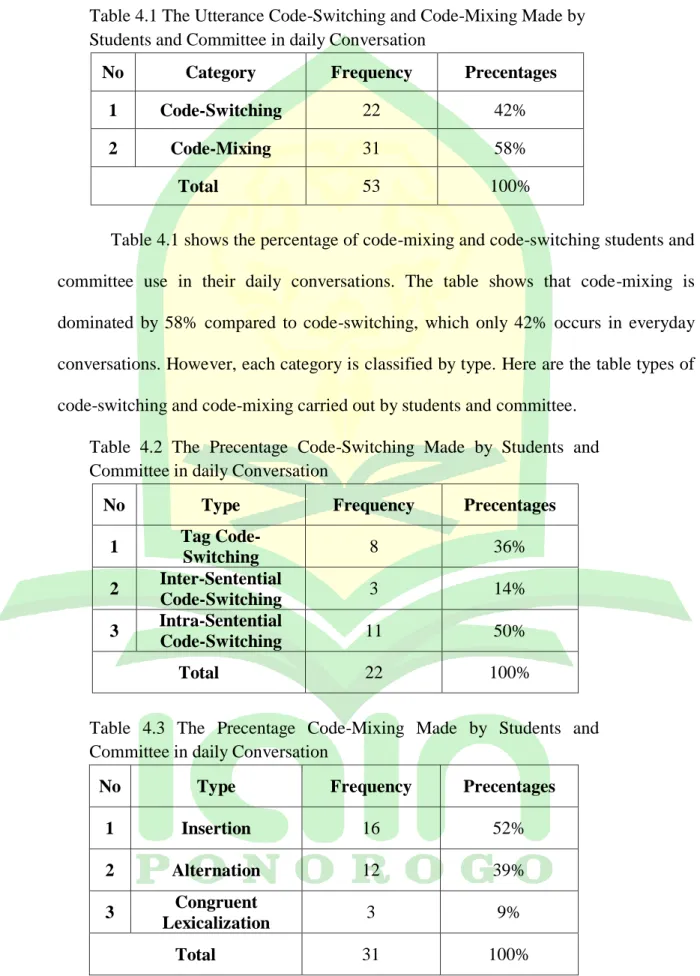
Discussion
The Forms of Code-Switching
In addition to interviews, the researcher found factors of code-switching and code-mixing that occurred in As-Sa'idiyyah Islamic Boarding School 2 from the results of observations. But in the observation results, the researcher found only six factors that cause code-switching and code-mixing in As-Sa'idiyyah Islamic Boarding School 2. Tag code-switching is simply inserting a tag in one language into an utterance that it is entirely in another language.
Code switching at the clause or sentence boundary is known as inter-clause code switching. Because the speaker used English in the first sentence before switching to Indonesian in the second, these data included code-switching between sentences. The kind of code-switching known as intra-sentential switching is a change of language that occurs in the middle of a sentence without any pause, hesitation, or pauses to indicate a change.
The researcher found that compared to label switching and intersentential switching, intersentential switching constitutes a more important part of code switching.
The Forms of Code-Mixing a. Insertion
As can be observed from extract 23, "endi iki kok gak onok wonge" is a sentence in Javanese, but the speaker smoothly switches to another language in the next sentence. In this case, the statements are only in the form of clauses, and each clause uses different language. S1 : I put it in the usual place, hee shapka dighasab, kah arek-arek iki gak duwe aturan.77.
As for the utterances spoken in the form of clauses for every other language. S1 : I put in the usual place, hee min slipper dighasab, kah arek-arek iki gak duwe aturan.85. In the data above, a student looks for and asks in English about the location of his sandals, which are not where he usually places them.
In the conversation above, it can be seen that the students are advised by the committee because there is no shortage of them.
Conclusion
Suggestion
Alih kode dan campur kode bahasa Wolio dalam bahasa Indonesia di SKPD Kota Baubau. Journal of Cultural Studies, 2021. Alih kode dan campur kode sebagai jembatan dalam bertutur antara siswa kelas satu MTs Al-Amin Mojokerto.” Surabaya: IAIN Sunan Ampel, 2012. Alih kode dan campur kode di acara musik televisi Korea After School Club.” Jakarta: UIN Syarif Hidayatullah 2014.
Interaksi Komunikasi dalam Kelas Pertunjukan Drama Dialog Mahasiswa Jurusan Bahasa Inggris STBA Nusa Mandiri Ciputat (Studi Komunikasi Etnografi).” Jurnal, Seminar Nasional Inovasi dan Tren (SNIT), 2014. Alih kode sebagai tanda interferensi bahasa, kasus EFIK bilingual.” International Journal of Asian Social Science, 2013. Rahim, Abdul Rahman, dkk., “Analisis Alih Kode dan Campur Kode dalam Interaksi Jual Beli di Pasar Pabbaeng Kota Makassar.” Kredo, 2020.
Sari, Maya, et al., “Code-Switching and Code-Mixing Used by Guest Star in Hotman Paris Show”, JELL, Vol.5, No.
